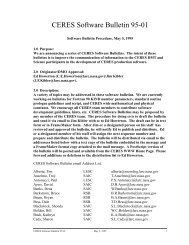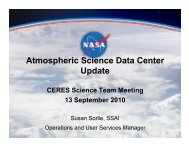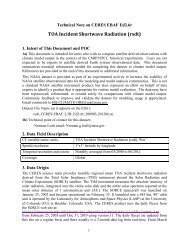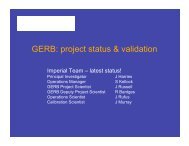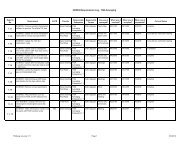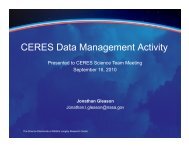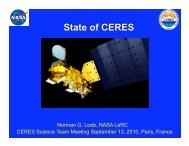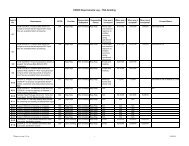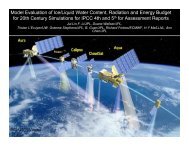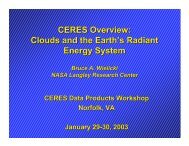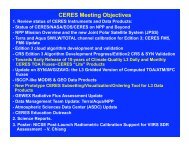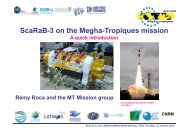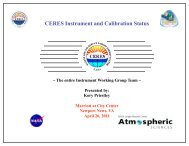(ceres) validation plan monthly regional toa and surface ... - NASA
(ceres) validation plan monthly regional toa and surface ... - NASA
(ceres) validation plan monthly regional toa and surface ... - NASA
Create successful ePaper yourself
Turn your PDF publications into a flip-book with our unique Google optimized e-Paper software.
CERES Validation Plan - Subsystem 10.0 Release 4.0<br />
<strong>surface</strong> all-sky flux, 4) LW <strong>and</strong> SW <strong>surface</strong> clear-sky flux, <strong>and</strong> 5) column-averaged cloud properties.<br />
This data product offers the best opportunity for comparisons of <strong>monthly</strong> means calculated<br />
using the ERBE-like temporal interpolation technique <strong>and</strong> the geostationary-enhanced technique<br />
since both methods will be used with identical temporal sampling <strong>and</strong> spatial gridding resolution.<br />
Regional <strong>monthly</strong> means will be compared directly using the two <strong>monthly</strong> products created by<br />
this subsystem. Time series plots, zonal, <strong>and</strong> global averages of TOA fluxes <strong>and</strong> scene identification<br />
will also be compared with previously validated ERBE-like products using the tropical mean<br />
technique described in the <strong>validation</strong> <strong>plan</strong> for Subsystem 3.0. Scatter plots comparing 1.0 degree<br />
regions with corresponding 2.5 degree ERBE-like regions will also be used to study the effects of<br />
the diminished temporal sampling of the 1.0 degree product.<br />
Monthly mean <strong>surface</strong> fluxes will be compared with <strong>monthly</strong> mean fluxes determined from<br />
<strong>surface</strong> observations at <strong>NASA</strong>/LaRC Chesapeake Lighthouse, Boulder Tower, BSRN (Baseline<br />
Surface Radiation Networks), CAVE (CERES/ARM Validation Experiment), <strong>and</strong> other ARM<br />
(Atmospheric Radiation Measurement) sites. The Subsystem 10.0 algorithm assumes that <strong>surface</strong><br />
fluxes can be calculated for each hour of the month using temporally interpolated TOA fluxes. The<br />
<strong>surface</strong> sites will provide hourly observations of <strong>surface</strong> fluxes that will also allow determination<br />
of instantaneous interpolation errors of <strong>surface</strong> flux due to this assumption. For global assessments<br />
of errors in <strong>surface</strong> fluxes, comparisons will also be made with results of the GEWEX/SRB<br />
project.<br />
This product also includes column-averaged cloud properties. Several different weighting<br />
schemes are used to conserve radiative properties such as TOA or <strong>surface</strong> downwellig LW flux.<br />
These weighting schemes will be tested using the CAGEX data set (Charlock <strong>and</strong> Alberta, 1996).<br />
If successful, these column clouds should produce mean cloud conditions consistent with the<br />
quantity being conserved.<br />
The geostationary-enhanced interpolation products will also be compared with two new satellite<br />
data products, if available. The combination of the European Geostationary Earth Radiation<br />
Budget (GERB) radiative fluxes <strong>and</strong> cloud properties derived from the SEVIRI instrument on the<br />
METEOSAT Second Generation Satellite will provide an excellent, high temporal resolution data<br />
set. Cloud properties from SEVIRI would be of greatest value if derived with an algorithm that is<br />
consistent with CERES <strong>and</strong> can therefore be directly compared with the CERES interpolated values.<br />
Monthly mean fluxes will also be compared with the GERB averages. An additional <strong>validation</strong><br />
data set will be from the Triana mission. The Triana hemispherical albedos <strong>and</strong> LW fluxes<br />
will provide a comparison of the globally integrated CERES fluxes. Cloud properties from Triana<br />
can also be compared with the interpoalted cloud properties from the geostationary data.<br />
10.2.2 Sampling requirements<br />
In order to validate SRBAVG data product, we will require a minimum of six months of data<br />
from each of the CERES satellites. Validation priority will be for 1) the first month of data; 2) 4<br />
seasonal months (January, April, July, October); 3) the first full year of data. Additional data<br />
August 2000 3



